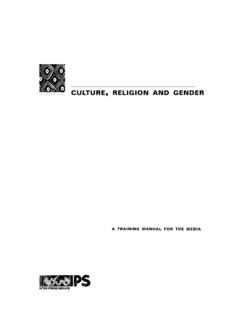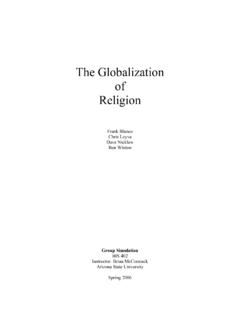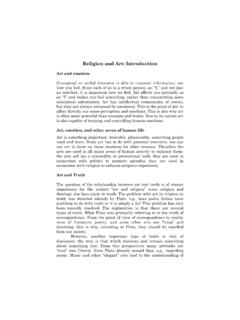Transcription of Gender, Religion and Caste - NCERT
1 gender , Religion and Caste39 Chapter 4 Gender, Religion andCasteOverviewIn the previous chapter we noted that the existence of social diversitydoes not threaten democracy. Political expression of social differencesis possible and sometimes quite desirable in a democratic system. Inthis chapter we apply these ideas to the practice of democracy inIndia. We look at three kinds of social differences that can take theform of social divisions and inequalities. These are social differencesbased on gender , Religion and Caste . In each case we look at thenature of this division in India and how it gets expressed in also ask whether different expressions based on these differencesare healthy or otherwise in a democracy. NCERTnot to be republished40 Democratic PoliticsGender and politicsLet us begin with gender division.
2 Thisis a form of hierarchical social divisionseen everywhere, but is rarely recognisedin the study of politics . The genderdivision tends to be understood as naturaland unchangeable. However, it is notbased on biology but on socialexpectations and divisionBoys and girls are brought up to believethat the main responsibility of women ishousework and bringing up is reflected in a SEXUAL DIVISION OFLABOUR in most families: women do allwork inside the home such as cooking,cleaning, washing clothes, tailoring,looking after children, etc., and men doall the work outside the home. It is notthat men cannot do housework; theysimply think that it is for women toattend to these things. When these jobsare paid for, men are ready to take upthese works.
3 Most tailors or cooks inhotels are men. Similarly, it is not thatwomen do not work outside their villages, women fetch water, collectfuel and work in the fields. In urbanareas, poor women work as domestichelper in middle class homes, whilemiddle class women work in offices. Infact the majority of women do somesort of paid work in addition todomestic labour. But their work is notvalued and does not get result of this division of labouris that although women constitute halfof the humanity, their role in public life,especially politics , is minimal in mostsocieties. Earlier, only men were allowedto participate in public affairs, vote andcontest for public offices. Gradually thegender issue was raised in in different parts of the worldorganised and agitated for equal were agitations in differentcountries for the extension of votingrights to women.
4 These agitationsdemanded enhancing the political andlegal status of women and improvingA poster from Bengal affirming women division of labour:A system in which all workinside the home is eitherdone by the women of thefamily, or organised bythem through thedomestic not? Ifpolitics is aboutpower, thensurely maledominance in thehousehold shouldbe are wediscussing thingslike householdwork in thistextbook onPolitical Science?Is this politics ? Zuban NCERTnot to be republishedGender, Religion and Caste41their educational and careeropportunities. More radical women smovements aimed at equality in personaland family life as well. These movementsare called FEMINIST expression of genderdivision and political mobilisation on thisDiscuss all these perceptions of an ideal woman that prevail in our society.
5 Do youagree with any of these? If not, what is your image of an ideal woman?Feminist: A womanor a man whobelieves in equal rightsand opportunities forwomen and men. Zubanquestion helped to improve women srole in public life. We now find womenworking as scientists, doctors, engineers,lawyers, managers and college anduniversity teachers which were earlier notconsidered suitable for women. In someparts of the world, for example in NCERTnot to be republished42 Democratic PoliticsPatriarchy: Literally,rule by father, thisconcept is used to referto a system that valuesmen more and givesthem power generating work6:002:40 Household and related work0:305:00 Talking, Gossip1:251:20No work/ Leisure3:403:50 Sleep, self-care, reading :2511:10 Daily time use (hours: minutes)Source: Government of India, Time Use Survey, 1998-99.
6 +A time use survey was conducted in six states of our country. Itshows that an average woman works every day for a little overseven and half hours while an average man works for six and ahalf hours. Yet the work done by men is more visible becausemost of their work leads to generation of income. Women also doa lot of direct income generating work, but the bulk of their workis household related. This work remains unpaid and countries such as Sweden,Norway and Finland, the participationof women in public life is very our country, women still lag muchbehind men despite some improvementsince Independence. Ours is still a male-dominated, PATRIARCHAL society. Womenface disadvantage, discrimination andoppression in various ways: The literacy rate among women isonly 54 per cent compared with 76 percent among men.
7 Similarly, a smallerYou can conduct a similar time use survey in your own all the adult male and female members of your family forone week. Every day note down the number of hours each ofthem spends on the following activities: income generatingactivity (working at the office or shop or factory or field, etc.),household related activity (cooking, cleaning, washing, fetchingwater, looking after children or elders, etc.), reading andrecreation, talking/gossiping, self-care, taking rest or sleeping. Ifnecessary make new categories. Add up the time taken on eachactivity for a week and calculate the daily average for each activityfor each member. Do women work more in your family as well? NCERTnot to be republishedGender, Religion and Caste43 Mummy alwayssays to outsiders: I don t work.
8 Iam a housewife. But I see herworking non-stopall the time. Ifwhat she does isnot work, whatelse is work?Map not to scaleproportion of girl students go for higherstudies. When we look at school results,girls perform as well as boys, if notbetter in some places. But they drop outbecause parents prefer to spend theirresources for their boys education ratherthan spending equally on their sons anddaughters. No wonder the proportion ofwomen among the highly paid andvalued jobs is still very small. On anaverage an Indian woman works onehour more than an average man everyday. Yet much of her work is not paidand therefore often not valued. The Equal Remuneration Act, 1976provides that equal wages should be paidto equal work.
9 However in almost allareas of work, from sports and cinema,to factories and fields, women are paidless than men, even when both do exactlythe same work. In many parts of India parentsprefer to have sons and find ways tohave the girl child aborted before she isborn. Such sex-selective abortion led toa decline in child sex ratio (number ofgirl children per thousand boys) in thecountry to merely 914. As the mapSource: UNFPA, Mapping the Adverse Child Sex Ratio in India, 2005, you identify your district on this map?What is the child sex ratio in it? How is itdifferent from others with a different colour?Identify the States where most districts havechild sex ratio below this map with the poster on the nextpage. How do the two of them tell us about thesame issue?
10 CHILD SEX RATIOBELOW 800800-849850-899900-949950 AND ABOVEDATA NOT AVAILABLEDELHINATIONAL AVERAGE 914(2011 Census) NCERTnot to be republished44 Democratic politics Oxfam GBshows, this ratio has fallen below 850 oreven 800 in some are reports of various kindsof harassment, exploitation and violenceagainst women. Urban areas havebecome particularly unsafe for are not safe even within their ownhome from beating, harassment andother forms of domestic s politicalrepresentationAll this is well known. Yet issues relatedto women s well being or otherwise arenot given adequate attention. This has ledmany feminists and women s movementsto the conclusion that unless womencontrol power, their problems will notget adequate attention.


















